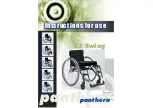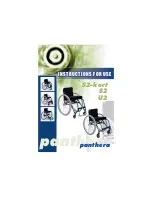
13
IV. WHEELCHAIR USE & CONFIGURATION
D. Transit Use (Continued)
•
The rider must be in a forward-facing position.
•
The rider and all items carried must not weigh more than 125 lbs (57 kg).
•
Backpacks and pouches should be removed and secured separately in the motor vehicle.
In the event of an accident these items can become dangerous projectiles, which may
injure or kill you or other occupants of the motor vehicle.
•
The rider must use a Wheelchair Tie-down and Occupant Restraint System that complies
with RESNA WC-4, Section 18: Wheelchair tie-down and occupant restraint systems for
use in motor vehicles or ISO 10542-1 Technical systems and aids for disabled or
handicapped persons -- Wheelchair tie-down and occupant-restraint systems -- Part 1:
Requirements and test methods for all systems.
•
Attach the wheelchair tie-downs to the four securement points (two front, two rear) on the
wheelchair with the transit option (Fig. 1) in accordance with the wheelchair tie-down
manufacturer’s instructions and RESNA WC-4, Section 18 or ISO 10542-1, - Part 1.
•
Attach occupant restraints in accordance with the occupant restraint manufacturer’s
instructions and RESNA WC-4, Section 18 or ISO 10542-1, Part 1.
•
Use of lap belts, chest straps, shoulder harnesses, any other positioning strap system or
positioning accessory should not be used, or relied on as an occupant restraint, unless it
is marked as such by the manufacturer in accordance with RESNA WC-4, Section 18 or
ISO 10542-1, Part 1.
•
Use of headrests, lateral supports or other positioning accessories should not be used, or
relied on as an occupant restraint, unless it is marked as such by the manufacturer in
accordance with RESNA WC-4, Section 18 or ISO 10542-1, Part 1 or RESNA WC-4,
Section 20: Wheelchair seating systems for use in motor vehicles or ISO 16840-4
Wheelchair seating -- Part 4: Seating systems for use in motor vehicles.
•
After being fitted and adjusted, the top of the original equipment back upholstery should
be within 4 inches (10,16 cm) of the top of your shoulder.
•
Any aftermarket seating should be tested to comply with RESNA WC-4, Section 20 or
ISO 16840-4 - Part 4.
•
Attach the seating to the wheelchair frame in accordance with the seating manufacturer’s
instructions and RESNA WC-4, Section 20 or ISO 16840-4 - Part 4.
•
Aftermarket accessories such as trays, oxygen tank holders, oxygen tanks, IV poles, back
packs, pouches and items not manufactured by Ki Mobility should be removed and
secured separately in the motor vehicle. In the event of an accident, these items can
become dangerous projectiles which may injure or kill you or other occupants of the
motor vehicle.
•
If the wheelchair has been involved in an accident, you should not continue to use it, as it
may have suffered fatigue, or damage, that may not be visible.
Fig. 1
Содержание Little Wave
Страница 1: ...2021 03 11...
Страница 33: ...2021 03 11...
Страница 66: ......
Страница 67: ......
Страница 68: ...Ki Mobility 5201 Woodward Drive Stevens Point Wisconsin 54481 715 254 0991 www kimobility com DCN0265 0...















































